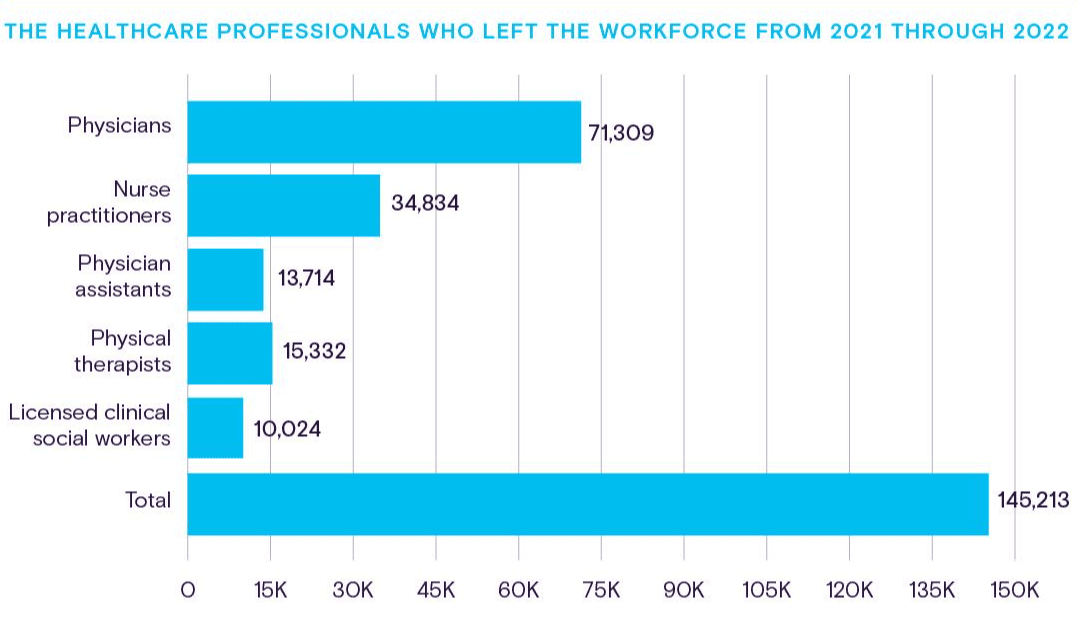
Hiring Metrics
Optimize and analyze your hiring process by tracking and measuring the effectiveness and success of your recruitment efforts.

TL;DR: Healthcare Worker Shortage
Definitive Healthcare reports that during 2021 through 2022, 71,309 physicians and 34,834 nurse practitioners left the workforce. An alarming number of licensed clinical social workers (10,024), physical therapists (15,332), and physician assistants (13,714) have also left the workforce.

While some of this is related to an aging workforce, the healthcare worker shortage is also affected by other factors:
Healthcare organizations should implement effective recruitment and retention strategies so their workforce feels supported and prepared for the future. Robust benefits packages and career advancement opportunities are part of the solution. There are additional creative and effective strategies that can help healthcare hiring managers meet their high staffing needs.

By 2026, researchers predict that there will be a critical shortage of approximately 3.2 million healthcare workers, according to an EMSI data analysis. In addition to a physician shortage, healthcare organizations will also experience a critical nursing shortage.
If you experience a talent shortage within your own company, how will you fill the gap? Consider these four innovative nursing shortage solutions.

Most healthcare professionals begin their job search online, and all the sites below can help you recruit top talent!
For many healthcare workers, CareerBuilder is their first stop. Healthcare talent can set up email alerts for current job openings that are a good fit for them.
Like CareerBuilder, Indeed is another go-to resource for healthcare job seekers.
As a key partner with hospitals, Hospital Careers posts current job openings and places healthcare talent in positions across the country.
Members of this social platform community can participate in "Medical Mingle," where they can interact with one another through articles, forums, and support groups. Moreover, HealthJobsNationwide has a job database where healthcare talent can search for positions based on specialty, location, job type, and more.
With more than 6,500 employers in their network, Health e-Careers is used by some of the biggest names in the healthcare sector.
In addition to a job search tool, this website gives healthcare professionals free resources, such as a career learning center, coaching, and webinars.
Pharmacists, nurses, biotech workers, and dentists can find job listings on this site.
The cost of healthcare recruiting is staggering, both financially and in time to fill. Industry experts estimate that it can take a minimum of 84 days to fill entry-level roles, at a cost of approximately $2,167. For mid- and senior-level positions, the financial cost and time it can take to recruit top talent can double and triple.
A healthcare labor market whitepaper recommends automating and digitalizing hospital and health HR systems to manage high recruitment and onboarding volumes. Recruitment software can handle any of the stages of your hiring process and can be automated to save time and money.
Structured Interviews
Structured interviews are one of the best tools available to recruiters to ensure a fair and consistent evaluation. They have the potential to minimize hiring biases while giving the greatest predictive validity of a good hire.
Pre-Recorded Video Interviews
With pre-recorded video interviewing software, you can free up many of the administrative hours often spent on candidate screening, and the cost-to-hire is up to six times less expensive than phone interviews. Most importantly, the healthcare talent can open a link and attend their interview at their convenience.
Automated Scheduling
With automated interview scheduling, you can integrate multiple calendars to ensure that you don't accidentally double-book candidates. You can also offer options to candidates that allow them to choose how they prefer to interview with your company:
Applicant Tracking System
Automatically update candidate profiles as they progress through the interviewing and evaluation processes. You can also auto-tag key skill sets and qualifications to highlight while reviewing the interview. Using built-in structured tools, you can rate, sort, and rank applicants fairly.
Automated Reference Checking
Without making a single phone call or sending an email, you can get insights into your applicants. Candidates enter their references' details, and a questionnaire is automatically sent to the references.
Candidate Sourcing Tools
The most efficient tools for sourcing candidates enable your talent team to expand beyond their normal reach. These tools give your team access to new talent pools, especially when they’re looking for specialized skill sets for hard-to-fill job positions.
Healthcare providers can boost retention by utilizing the capabilities of their human resource information systems to improve the employee experience. Some systems even come equipped with candidate sourcing and management features. To stay ahead in a highly competitive market, use specialized recruitment tools such as an applicant tracking system.
Your search for healthcare talent isn't just immediate. Successful healthcare recruiters need to consider long-term strategies. Think about where your current and future candidates are, and meet them there, whether it's at a local community college or career fair.
In addition to focusing on the job you're trying to fill, have conversations with your candidates about their careers in healthcare. Instead of trying to sell them on the position, sell potential recruits on the career. This involves being proactive in your recruiting.
For a long-term recruiting strategy, consider these recruitment opportunities.

Because healthcare is such a competitive market, attractive benefits packages are essential if you hope to attract the most qualified applicants. In the past, candidates who were job-seeking looked primarily at salary, healthcare benefits, paid time off, and investment options. In today's competitive climate, employers have to go beyond the basics.
Consider offering these benefits.
Flexible shifts and scheduling
A traditional work week will suit some employees, but others may need more creative scheduling that fits their family and personal life. Avoid a one-size-fits-all approach.
Access to health and wellness programs
Healthcare is a stressful industry, and it's important that employees have access to programs that allow them to more effectively address their own health needs.
Training opportunities
When you invest in employee training and continuing education, it's a win-win situation.
The recruitment and hiring process is costly. Once you've recruited top healthcare talent, what can you do to keep them? These research-based innovative strategies can help you keep your healthcare talent engaged.

Every employee has different needs and priorities, and adopting a persona-based strategy will help you keep your top talent and develop your emerging talent. Gen Z recruitment in healthcare, for example, looks very different compared to hiring Gen X.
Gen Z workers appreciate a company that offers opportunities to thrive and diverse perspectives. A study by Tallo found that 99% of Gen Z employees (individuals born after 1996) identify diversity, equity, and inclusion (DEI) as important in the workplace.
According to a report by NSI Nursing Solutions, one of the primary reasons healthcare employees resign from their jobs is for career advancement. If you can offer this from within, you have a stronger chance of keeping your top talent. Also, consider making an internal promotion policy.
Employees who have a solid work-life balance are more likely to be happy in their current positions. Every family has different needs, and when you help your healthcare talent find a schedule that works for them, you stand a better chance of having a lower employee turnover rate.
One of the top three employee value proposition (EVP) elements is work flexibility. A survey conducted by the Institute for Corporate Productivity found that 49% of respondents considered creative flexibility to be one of their top three considerations in job satisfaction.
Here are some ideas for creative flexibility in scheduling:
You can also use digital tools to track and structure your staff schedules. You can allow employees to use an app for finding last-minute replacements, providing shift coverage, and simplifying staff schedules.
Burnout can be a problem in any industry. However, statistics show that healthcare professionals experience it at higher rates than other professions.
Consider these concerning burnout statistics:
To reduce burnout in healthcare talent, consider including more paid time off, encouraging employees to use their vacation time, and separating PTO and sick days into two different categories.
The nursing home industry is facing significant staffing shortages, with 99% of nursing homes and 96% of assisted living facilities facing staffing shortages in a recent American Health Care Association survey. To compensate, most respondents stated they regularly ask staff to work overtime.
If you're a healthcare professional, your skills are in higher demand than ever. The keys to a rewarding career in healthcare depend on a few different factors.
Learn top tips and best practices from other healthcare professionals to set yourself up for a successful career in your profession.

Most job sites now allow companies to identify whether their posted role is hybrid or remote. These sites often, but not always, include a “remote” filter in the job seekers’ search options. If it’s not available, try typing “remote” in the search criteria, or in the “location” bar.
Healthcare talent is in high demand, and the looming shortage has you well-positioned to be selective about where you want to work. In addition to competitive salaries, look for benefits such as health and wellness programs, both PTO and sick days, retirement savings plans, and flexible scheduling.
Healthcare professionals are in demand everywhere, but some areas have more opportunities in terms of competitive pay. For example, hospitals and other organizations in rural areas are often willing to offer higher salaries than similar employers in more populated areas to attract quality talent. Additional benefits of a rural lifestyle can include a lower cost of living, expanded recreation options, and a slower pace of life.
Self-assess your skills, whether you're starting your first job search or looking to transition to a new one.
When you compile your resume and cover letter, keep these lists in mind. These lists will also help you prepare for interviews.
The healthcare industry has hit a critical level in its need for workers. Between now and 2030, more than one million registered nurses are set for retirement. Employers who are prepared and proactive can more effectively manage their workforce.
Doubling down on support for a diverse workforce, ensuring that healthcare professionals know their worth, and offering competitive benefits that go beyond salary will help you be ready for the challenges that are coming.
The healthcare worker shortage is caused by several factors, including the aging population requiring more care, high burnout rates, insufficient healthcare training programs, low wages for some positions, and the pandemic, which exacerbated stress and led to many workers leaving the field.
Nurses, especially registered nurses (RNs), are the most affected. Other healthcare professionals like doctors, medical assistants, respiratory therapists, and paramedics are also facing shortages, though the severity can vary by region.
The shortage leads to longer wait times, overworked staff, decreased patient satisfaction, and potentially lower quality of care. Healthcare facilities may also experience higher rates of medical errors and burnout among the staff, further compounding the issue.
Healthcare organizations can address the shortage by improving worker retention through better working conditions, providing higher wages or benefits, offering mental health support, expanding training programs, and attracting international workers.
Modernize your hiring process with expert insights and advice.